Sunday, November 25, 2012
Vietnamese Ethnic Culture Village Calls for investment
PARIS, Dec 12 (Bernama) -- A project to build the culture-tourism village of Vietnamese ethnic groups was introduced to investors and friends at a talk held here on Saturday, Vietnam News Agency (VNA) reported.
Hoi An: Walking in the footsteps of history
Hoi An has been trading with the outside world since almost the 15th century. Once one of the busiest ports in all of South East Asia, the docksides of this relatively small central Vietnamese town were once awash with the sound of Chinese, Japanese, American, European and Indonesian traders, all bringing their wares to Vietnam’s doorstep. Warehouses strained under the weight of the orient’s finest silks and spices. Everything, from elephant tusks to beeswax, from paper to porcelain, was brought here and from here to the world.
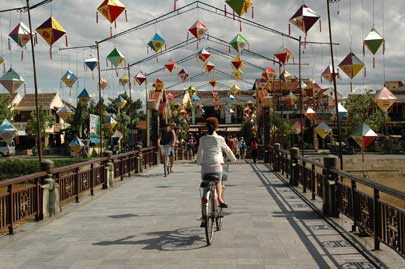
Cycling over Cam Nam Bridge.
Hoi An still maintains a brisk trade with all its old business partners. However, it’s now Hoi An’s cash tills rather than its docks that ring to the sound of international commerce. Hoi An, with its traditional housing and narrow streets, all unspoilt by the passage of time, is a tourist mecca. Apart from the faces, little has changed in Hoi An since its commercial hey day. The nations of the globe still flock here, now to wander its ancient streets and marvel at a piece of Vietnam’s living history.Hoi An’s close relation to the rest of the world has worked to define the very bones of the town. Chinese and Japanese traders, particularly, extended their long stays in port to establish permanent agencies here from which to manage their trade. From these beginnings, sprang the first permanent Chinese settlement in Southern Vietnam, whose congregational assembly halls still draw both the descendants of those early Chinese traders and tourists alike. 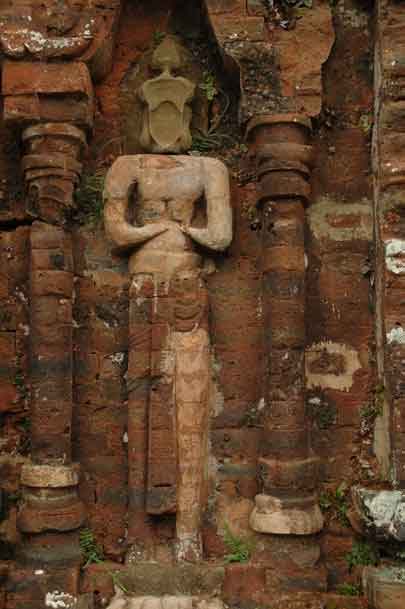 Cham ruins at My Son. - Photos: Simon Speakman Cordall Within its narrow walls, around halfway across, stands the temple of the northern God Tran Vo Bac De, critically for sailors, the God of weather. One legend about the bridge is that it as built to subdue the enormous ‘mamazu’ dragon monster, whose global reach stretched from its head in India to its tail in Japan, the movement of which was supposed to cause earthquakes. Vietnam, and principally Hoi An, was thought to sit across its back, so building the bridge at this spot would pin the Mamazu down and protect those the traders and settlers had left behind. However, Hoi An, and its surrounds, date back further than the international trade which later came to define the town. Around 55km outside of Hoi An’s centre can be found the ruins of My Son, once the political and religious centre of the Champa Kingdom. The Cham, who still exist within Vietnam today, once ruled the central provinces of modern Vietnam before being absorbed by the Vietnamese in around the 17th Century. My Son, the most significant and extensive Champa sites in Vietnam, dates back to the 4th -10th Century and its Indian influenced ruins are an easy motorbike ride away. Though it may seem suffocated by the sheer number of tourists who make their way here, Hoi An’ beauty - unspoilt by either time or war - still offers visitors a unique glimpse into Vietnam’s historic past. To walk Hoi An’s historic streets is to walk in the footsteps of those traders and merchants who built so much of this town and, in their own way, helped to shape the Vietnam of today. |
Thursday, November 22, 2012
Russian tourists lured in Southcentral region
The number of flights from Russia’s Far East region to Cam Ranh international airport in the southcentral region will increase from 7-9 to 21 per week as from October 25.
The decision was made at a meeting between the Khanh Hoa provincial People’s Committee and local departments on October 11 to serve the tours co-organized by Vietnam’s Anh Duong Production, Service and Import-Export Company and Russia’s Pegas Turistik Company.
These tours have been in operation since late October, 2011, through which as many as 60,000 Russian have come to visit Vietnam. 60-70 percent of them have preferred staying first in Nha Trang than in Binh Thuan, Ninh Thuan, Phu Yen and Quang Nam.
Hoang Thi Phong Thu, CEO of Anh Duong Production, Service and Import-Export Company, said almost all tourists were pleased to enjoy good accommodation, beautiful scenery and delicious food and often stayed for 7 to 10 days in 3-5 star hotels.
Since early this year, Khanh Hoa has received 383,000 foreign tourists, including 50,000 Russian, up 27 percent compared to the same period last year.
The province is expected to welcome 550,000 foreign tourists by late 2012.
Enjoy Dreamlike Beauty of Mui Nai Beach- Ha Tien- Kien Giang
Ha Tien in Kien Giang province is very famous for its beautiful landscapes. Many beaches, mountains, cave temples and pagodas are gathered here. The beaches are very clean and naturally beautiful. Of which is Mui Nai. Coming to this beach, tourists in Vietnam travel feel safe when swimming and they can join sports on the beach.
Annually, Mui Nai Beach in Ha Tien attracts thousands of tourists in Vietnam travel coming to visit. The beach is very beautiful and dreamlike with brown sand and blue sea. Tourists can swim and see the sunset in the evening. Tourists can enjoy sunbathing on Mui Nai beach without being disturbed. There are some lifeguards along the beach to keep people safe and prevent stealing or conflicts.
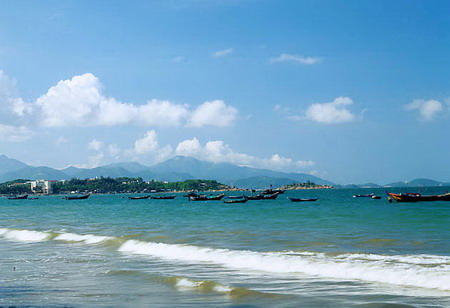
Mui Nai Beach- Ha Tien- Kien Giang
Additionally, Mui Nai built a mini water park for the children nearby the beach. The children can play games, swim together and their parents do not have to worry about them. Next to the beach, there is a small market that sells sea food such as lobsters, sea crabs and squids. This market also sells souvenirs which are made from tortoise-shells for tourists in Vietnam tourism to buy as presents for their relatives and friends.

Mui Nai Beach- Ha Tien- Kien Giang
If you plan to come to Vietnam on the occasion of your holidays and especially you are a lover of beach, Mui Nai in Ha Tien, Kien Giang should not be missed on your journey!
Wednesday, November 21, 2012
The National Circus Gala
The National Circus Gala this week will be the last time the Ho Chi Minh City Circus performs at the September 23rd Park, its home for more than a decade. Nomadic life continues after 12 years in a downtown park.
The Ho Chi Minh City Circus at September 23rd Park. The park will soon become a bus station and the circus will have to relocate.
The park will soon become a bus station and the circus will have to relocate, and it is not the first time it has been asked to do so.
Nearly 70 artists will take part in the October 19-21 gala, a precursor to the International Circus Festival to be held in Hanoi next month.
It will feature some famous circus artists from Hanoi, Quang Tri and Hue, and the Vietnam Circus Association will nominate the top four performances to represent the country at the Hanoi festival.
But the gala is not the HCMC artists’ main concern right now since they have been asked to move out of September 23rd Park by the month’s end.
Phi Vu, 49, a versatile performer (a trapeze artist, a clown and other roles), told Vietweek that since its establishment in 1986, his troupe has been moved around several times.
“We have been living a nomadic life for many years, moving from a theater and swimming pool in District 5, then District 11, and recently, this [September 23rd] park. However, it looks as though this is not the final venue.”
The park in District 1 is not an ideal place for a circus, but its 3,000-square-meter area is the best and largest venue the HCMC Circus has had so far.
It gives them enough space for a full-fledged tent, a practice area, and room to care for a variety of animals including elephants, dogs, monkeys, horses, and a python.
Vu, who became the troupe’s first Meritorious Artist (a title granted by the government) in 1997 and has been a circus performer for 35 years, said it is not the first time that his troupe has been asked to move out of the park.
“In 2007 we were told we might have to go a different venue, the HCMC Zoo.
A performance by the HCMC Circus. The troupe will compete in the National Circus Gala October 19 to 21 in Ho Chi Minh City.
“[That] really puzzled us since it was too small for the substructures and equipment.
“Moreover, we were told to merge with other stage arts like puppetry to create something like a union of stage arts from the south. It would be messy to mix arts that do not match.”
Pham Van Xuyen, deputy director of the Vietnam Circus Association, told Phap Luat newspaper in an interview: “Technically, circus and puppetry cannot coexist under one roof due to their differences, and a strained merger never works.”
Ho Van Thanh, head of the HCMC Circus, told Vietweek that the first difficulty is fitting the tent in the zoo, where the allotted area is only 600 square meters.
“The next problem is the lack of space to keep tame animals amidst the wild ones. Moreover, the HCMC Wild Animal Protection Association does not allow us to care for our animals in the zoo, so we have to hire a private site for them. This will affect the training a lot.”
“Last but not least it takes a lot of money to upgrade to a soundproof tent in order not to disturb the high school next to the zoo. It will take a long time and money for us to do this and other things to set up in a different, much smaller place.”
Back in 2007, these arguments prompted authorities to allow the circus to stay on at their favorite place for five more years, although its infrastructure, including the tent and seating, animal enclosures and safety arrangements have deteriorated. The circus company has not had the money to maintain or upgrade its facilities.
Vu said the troupe has been asked to move out at the end of this month to make way for a bus terminal.
“But so far, concerned authorities have not offered any support.
“If we move to Gia Dinh Park in Go Vap District, around 10 kilometers from September 23rd park, as they want us to, our troupe will struggle even more. Audiences will not come from downtown areas to watch our show.”
Furthermore, Thanh said, the Go Vap Park would be just another temporary venue for his troupe.
“According to the government’s decision, our final destination will be an amphitheater in District 11. However, this is just a sketch that has remained on paper for years.”
Despite all the troubles the company has faced, including the lack of money and a permanent venue, it has tried to attract more viewers. The younger members of the circus, in particular, have been able to find name and fame for themselves in the international arena.
The company’s artists have won both national and international prizes, including a silver medal at the 1997 International Circus Festival in Hanoi and a bronze medal in North Korea in 2000.
It has also entertained audiences in many cities in France, Belgium, Taiwan and elsewhere.
Vu is also director of the upcoming National Circus Gala.
“Thanks to the money we have collected through extra shows and canvassing funds from enterprises and individuals, we are able to put up some good shows, not only for children but also adults, like the circus-drama ‘Romeo and Juliet,’ and this coming event.”
The circus has lost is popularity in Vietnam over the last two decades for various reasons. Both children and adults have favored other forms of entertainment (video games, reality shows etc.) Lacking funds to invest in training and offering better remuneration to the artists, circuses have laid themselves open to the charge of putting on monotonous shows and not being innovative.
In this situation, winning back the audience is not easy, Vu said.
“But this is the target of any art. We will never give up.”
It's hot and humid around year in Tay Ninh
The weather here is hot, humid around year with annual average temperature of 27.5 degrees.

Cao Dai Temple
Tay Ninh Town is 99km from Ho Chi Minh City. There are Moc Bai and Xa Mat border gates to Cambodia, Moc Bai Market is trade center of Vietnamese and Cambodian.
Coming to Tay Ninh, tourists are able to visit Ba Den Mountain, a famous complex of cultural and historical sites and beauty spots, and Binh Thanh Cham Tower, a monument of the Oc-Eo culture. Once a year, Ba Den Mountain Festival attracts many pilgrims come to pray, sightseeing and enjoy the entertainment.
Dau Tieng Lake is located on the way to Tay Ninh. The lake covers 27,000 ha and has a water reserve of 1,5 billion m3, irrigating Tay Ninh province as well neighbouring provinces. Dau Tieng Lake’s beautiful landscape of mountains, its fresh and pure atmosphere shall give visitors an agreeable feeling.
The weather here is hot, humid around year with annual average temperature of about 27.50C, annual rainfall of 1,724mm. The dry season lasts between December and April, the rainy season lasts from May to November.
Sunday, November 18, 2012
Waffles, Waffles and more
Caravelle Hotel in Ho Chi Minh City has unveiled some interesting culinary programs for November.
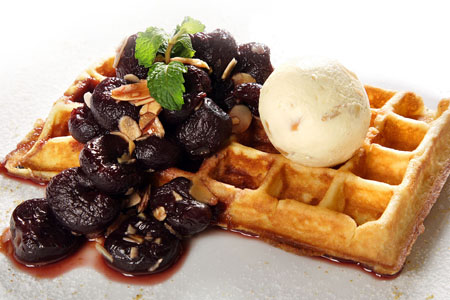
The talented chefs at Caravelle will serve six kinds of freshly baked waffles piping hot from the kitchen. Photo courtesy of Caravelle Hotel
The first features waffles served in the hotel's ground floor Lobby Lounge from November 16 to 22.The talented chefs at Caravelle will serve six kinds of freshly baked waffles piping hot from the kitchen. They will include toppings such as warm cherry stew with macadamia ice-cream, sautéed apples and vanilla bean sauce Anglaise, and the simple joys of natural icing sugar and maple syrup. The price is VND128,000++ for a portion. At the same time, the hotel’s Reflections Restaurant on the third floor will hold a special US beef promotion showcasing cuts of Black Angus strip loin, beef tenderloin, and rib eye. Enjoy fresh beef grilled over live coals. Each cut will be priced by weight from 150 to 350 grams, and served with classic steak sauces and a choice of two delicious side dishes. Prices range from VND450,000++ to VND990,000++ for 150 to 350 gram cuts. Reflections Restaurant will also present a Ruffino wine dinner to bring the renowned wine flavor to guests on November 21. The finest Sangiovese grapes from the most exceptional estates in Tuscany together with five courses of delectable gourmet cuisine are all the stars of the Ruffino wine dinner. Made from grapes grown in the winemaking heart of Italy, Chianti Ruffino is renowned as one of the first wines to cross the country’s border and for its role in introducing Italian wines to the world. Alan Wong, Ruffino’s brand ambassador in Asia, will represent the winery and the Folonari family at Reflections Restaurant, where guests will sample six vintages from Ruffino’s legendary cellars. The evening begins with canapés and a welcome drink of Orvieto Classico DOC 2011. A stellar Riserva Ducale Chianti Classico 2007 will be served with the fourth course of roast beef tenderloin with breaded artichokes, smoked potato puree, and tarragon-flavored bacon mushroom ragout. Price is VND1,480,000 nett per person. Along with these programs, the Nineteen Restaurant on the ground floor will also lay out a lavish Thanksgiving feast on Thursday, November 22. The Caravelle’s standout buffet restaurant is extending an invite to foodies, friends and families to partake of the most mouth-watering Thanksgiving dinner in town. Its chefs are preparing specialties from all over the world, together with a heaping selection of fresh seafood, as-you-like-it action stations serving hearty grilled and barbecued meats, and an overflowing line-up of appetizers, cheeses, soups, salads, and desserts to satisfy your palate. For traditionalists, there will be a succulent whole roasted turkey with stuffing, giblet and cranberry sauce, garlic potatoes, buttered vegetables, pumpkin pie, and more than enough gravy to go around. Price is VND1,013,000 per person with a free flow of red, rose and white wines. |
Cu Da village in Hanoi
At about 30km from Hanoi capital, Cu Đa village (Cu Khe commune, Thanh Oai district, Ha Tay province) has well-kept specifications of ancient Viet.
| In any hamlets or any lanes. There are vaulted gates. Village roads are laid with slanting bricks. On road-sides, there are old houses in ancient Viet styles, villas in French styles and newly-built ones. Houses are numbered and it might be the one and only village in Vietnam where houses got numbered. There are now round two hundred old houses both in Viet and French styles, of these, 60 remain almost unchanged. Houses in Cu Đa are low and deep in length, so they are always cool in summer and warm in winter. Architecture is specified in Nguyễn feudalist dynasty, nearly made of wood. On beams, pillars, there are delicate sculptures. In the middle of the houses, there are ancestral altars, panels and parallel scrolls. 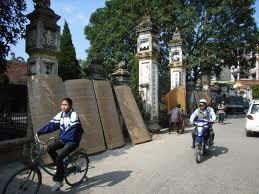 The main village road is built along a riverside, every lane has a gate. This specific planning could be only seen in ancient Viet village where the economy relies on agriculture and trading. The most convenient position of the village is being close to the market and river (it’s next to Ha Đong town and Hanoi). The village pagoda is classified as national relics, it’s Linh Minh Tu and a stone column is inscribed “the pagoda was renovated in 1695”. There also remains relic of the village altar to worship “earth and heavens” or Xã Tắc, considered to be the most magnificent. There are also houses that were built in years from 1920 – 1940 (in new architectural styles). On a river bank, there’s a flag-pole built in 1929, a communal house of the village-council, a school. At one end of the village (entry road), there’s a low earthen hill named Đống Già , it’s thought to be a centuries-old tomb since the old Chinese colony. |
Unique Tourism Opportunities in Mekong Delta
In context of the current economic woes in the world, the tourism sector is still striving to attract more people to visit the Mekong Delta area in Vietnam, which is offering unique, stress free and exotic tours.
The Ministry of Culture, Sports and Tourism has approved a plan to develop tourism as a key economic sector in the Mekong Delta. The plan, which extends till 2020, will aid the country's economic transformation and help reduce hunger and poverty, according to the ministry. Thanks to its cultural diversity and the range of tourism it offers, such as eco, community-based, sea and islands, and diverse culture, the Mekong Delta attracts millions of visitors each year. According to the Mekong Delta Tourism Association, around 12.8 million holidaymakers have visited the region since the beginning of the year, a year-on-year increase of 6 percent and a turnover of more than VND2.6 trillion ($125 million), an increase of 25 percent compared to last year. In provinces like An Giang, in October alone, the province has welcomed around 28,000 tourists, an increase of 2.6 percent compared to September. Among them were around 2,300 international travelers, an increase of 6.7 percent compared to September. October turnover alone was VND17 billion ($815,662), an increase of 3.9 percent compared to last month. There was a hike in holidaymakers from North Vietnam to the Mekong Delta and Cambodia, said Nguyen Dai Ho, director of the Phuong Nam Travel Company in Kien Giang. Accordingly, the company in coordination with the Hon Gai Tourism Company launched a new route Hanoi - Ho Chi Minh - Tay Ninh - Ha Tien - Phu Quoc -Hanoi. Kim Trang from the Hanoi Tourism Company shared that every month her company organizes a tour for six groups of 30 tourists who want to go to the Mekong delta city of Can Tho to listen to amateur music on a boat along the river, visit orchards in the Mekong delta province of Tien Giang, and the Mac Cuu mausoleum in the town of Ha Tien, in the Mekong Delta province of Kien Giang. Tommy, a representative of Fantasy Tour Company, said Vietnam has the magnificent Mekong River which foreigners love as it flows through six countries. His customers are interested in culture of the region, the natives and the natural beauty, rather than luxury hotels and sea bathing. Foreign tourists have a good eye for the Mekong River and 40 percent of tourists here are Japanese, said Nguyen Duc Tho, a tourist guide of HCMC-based Le Phong Travel Company.
Le Van Hien, chairman of Cuu Long Tourism Company, said the Mekong Delta Tourism Association and local tourism associations should train more tourist guides, waiters, and restore traditional festivals of ethnic minority groups like Khmer, Chinese, and Cham. More important was how to link the uniqueness of each province and build an alluring image of the whole region and offering specific tourism packages . There is also need to attract more investments and improve the basic infrastructure and accommodation since the region has the lowest rates of five-star hotels and resorts in Vietnam, said Hai Dang, Director of Vietravel Tourism Company. |
Friday, November 16, 2012
Adventure tourists enjoy pushing it to the limit in scenic Ninh Bình
The adventure tour is called the Ninh Bình Challenge. In the Challenge, participating tourists are divided into teams of three and begin their tour through an area known as “Ha Long Bay on land”, an area of rice paddies surrounded by majestic limestone karsts about 90km south of Ha Noi.
The gorgeous countryside and its water buffalo and green and gold rice paddies confirm all the postcard fantasies about Viet Nam.
“This is the first time I have taken part in this kind of adventure tour,” said Pham Thai Minh from Ho Chi Minh City. “The race is fun and the panorama is beautiful.”
“Amazing weekend in Ninh Bình! Biked, ran, climbed, rowed, zip lined instead of abseiled, and didn’t throw up once, haha!,” said tourist Adam Maingot. “Viet Nam truly is a beautiful country.”
The gorgeous countryside and its water buffalo and green and gold rice paddies confirm all the postcard fantasies about Viet Nam.
“This is the first time I have taken part in this kind of adventure tour,” said Pham Thai Minh from Ho Chi Minh City. “The race is fun and the panorama is beautiful.”
“Amazing weekend in Ninh Bình! Biked, ran, climbed, rowed, zip lined instead of abseiled, and didn’t throw up once, haha!,” said tourist Adam Maingot. “Viet Nam truly is a beautiful country.”
Chris Birt, a British geoscientist, said he had heard about Ninh Bình and decided to participate in the tour with a view to seeing everything with his own eyes despite having to fly over 1,700km from HCM City to Hanoi and take a two-hour bus ride to the province.
He was really satisfied by the unique tour, he said. Ninh Bình was a great travel destination with imposing and jagged mountains and children cheering as his team passed by. Birt said he would be back next year with his family so they could share the experience with him and visit Bai Dính Pagoda and the surrounding area.
“I was very impressed with the scenery,” said his teammate, American Joshua Turner. “The race was easier than I expected so I was able to enjoy the scenery while running.”
Turner’s team took the top position after two days of events. He cautioned, however, that Ninh Bình was not yet a great place for cyclists due to the truck traffic.
“My previous adventure race was west of Dallas, Texas, and was one long day,” Turner said. “The competition there was much tougher and we came in about 20th out of about 200. Ninh Bình is much prettier though and I’m sure it’ll be much more competitive next year.”
“I wanted to make something different for tourists in Viet Nam,” said Jean-Luc Voisin, director of the Viet Adventure Co, organiser of the Ninh Bình Challenge.
“I hope they can really see Vietnam through what’s happening in the villages, not only passing by and looking as tourists often do in normal tours,” Voisin said. “I have worked with the local residents for many years, and I hope that my customers will have chances to admire the beauty of the country through the daily lives of the people.”
He said he modeled the Challenge after adventure tours in southern provinces like Bình Thuan and Dong Nai after he realised that nothing similar was on offer in the north. He chose Ninh Bình after seeing it on a television documentary.
Cliffhanger: Tourists compete in the rock climbing event. — Photo courtesy of Pham Hoang Van
Adventure tours, said Voisin, help people discover their own limits through running, climbing, boating and biking.
“It’s a strong motivation for people to compete with themselves and prove that they can do a lot of different things and overcome challenges,” he said.
Participants in the Ninh Bình Challenge had to train regularly in preparation for their tour, which would require them to mountain bike for 50km before a 14km hike, 20m of rock climbing and 4km of boating.
“I went to a gym one month before the tour to improve my strength and endurance,” said Minh, who nevertheless suffered a cramp during the biking tour.
Birt and Turner said they went cycling every weekend and running four times a week to make sure that they would able to meet the Challenge.
Among around 50 adventurers, Jordan Kindness, a 10-year-old girl, was the youngest racer. But she brought a surprise to all the rivals by successfully passing all the obstacles and, together with her parents, winning the adventure category – even after sinking a traditional boat and having to start this part of the race.
Kindness met no difficulty in finishing the 25km biking and 8.5km running events. And while rock climbing and zip lining tested the strength and skills of the adult participants, for Kindness, it was a piece of cake.
“It’s hard to keep up with her – she has to wait for us,” laughed her parents.
For her performance, Kindness received a special offer to take part in Viet Adventure’s next event, the Madagui Trophy, in the Central Highlands province of Lam Dong in February.
He was really satisfied by the unique tour, he said. Ninh Bình was a great travel destination with imposing and jagged mountains and children cheering as his team passed by. Birt said he would be back next year with his family so they could share the experience with him and visit Bai Dính Pagoda and the surrounding area.
“I was very impressed with the scenery,” said his teammate, American Joshua Turner. “The race was easier than I expected so I was able to enjoy the scenery while running.”
Turner’s team took the top position after two days of events. He cautioned, however, that Ninh Bình was not yet a great place for cyclists due to the truck traffic.

“My previous adventure race was west of Dallas, Texas, and was one long day,” Turner said. “The competition there was much tougher and we came in about 20th out of about 200. Ninh Bình is much prettier though and I’m sure it’ll be much more competitive next year.”
“I wanted to make something different for tourists in Viet Nam,” said Jean-Luc Voisin, director of the Viet Adventure Co, organiser of the Ninh Bình Challenge.
“I hope they can really see Vietnam through what’s happening in the villages, not only passing by and looking as tourists often do in normal tours,” Voisin said. “I have worked with the local residents for many years, and I hope that my customers will have chances to admire the beauty of the country through the daily lives of the people.”
He said he modeled the Challenge after adventure tours in southern provinces like Bình Thuan and Dong Nai after he realised that nothing similar was on offer in the north. He chose Ninh Bình after seeing it on a television documentary.
Cliffhanger: Tourists compete in the rock climbing event. — Photo courtesy of Pham Hoang Van
Adventure tours, said Voisin, help people discover their own limits through running, climbing, boating and biking.
“It’s a strong motivation for people to compete with themselves and prove that they can do a lot of different things and overcome challenges,” he said.
Participants in the Ninh Bình Challenge had to train regularly in preparation for their tour, which would require them to mountain bike for 50km before a 14km hike, 20m of rock climbing and 4km of boating.
“I went to a gym one month before the tour to improve my strength and endurance,” said Minh, who nevertheless suffered a cramp during the biking tour.
Birt and Turner said they went cycling every weekend and running four times a week to make sure that they would able to meet the Challenge.
Among around 50 adventurers, Jordan Kindness, a 10-year-old girl, was the youngest racer. But she brought a surprise to all the rivals by successfully passing all the obstacles and, together with her parents, winning the adventure category – even after sinking a traditional boat and having to start this part of the race.
Kindness met no difficulty in finishing the 25km biking and 8.5km running events. And while rock climbing and zip lining tested the strength and skills of the adult participants, for Kindness, it was a piece of cake.
“It’s hard to keep up with her – she has to wait for us,” laughed her parents.
For her performance, Kindness received a special offer to take part in Viet Adventure’s next event, the Madagui Trophy, in the Central Highlands province of Lam Dong in February.
Wednesday, November 14, 2012
MIEN XAO CUA TRUNG- A SPECIAL DISH JUST HAS AT HANG THAN
Located at 1 Hang than, Old Quarter, Hanoi there is a pavement shop attracting many guests. This shop sells every kind of seafood such as clams, oysters…In addition to, there is also the most famous dish that almost guests love eating.
| Mien xao cua trung (crabs fried with vermicelli and eggs) is very hot here because of two following reasons: Firstly, the processing is not only delicious but also attractive. Secondly, it is extremely reasonable price-only 35,000 VND per dish and I can make sure that you will be satisfied. 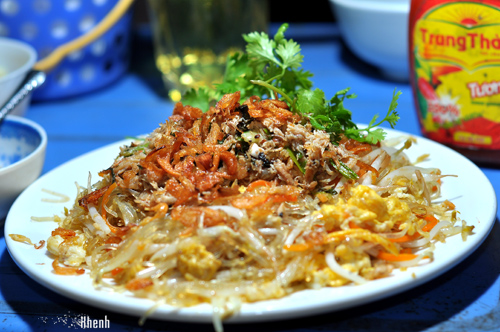
Mien xao cua trung dish seems very attractive
Mien xao cua is not too strange or fussy dish but it is very rarely to find the place but Hang Than having such delicious dish. Overcoming many years of experiences, chefs have processed this dish skillfully with the aim of serving customers best.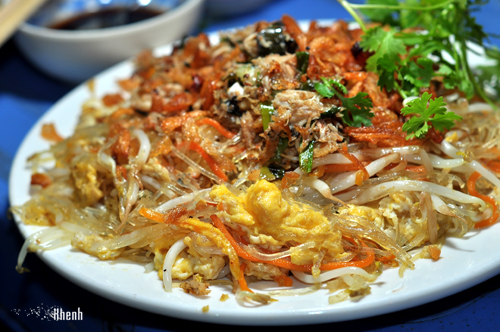 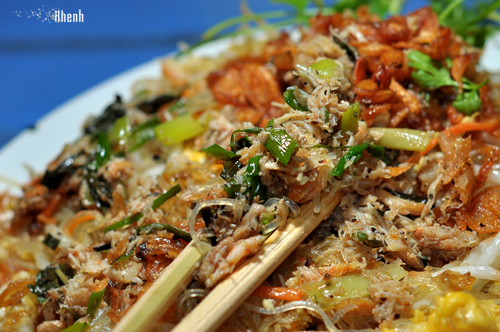 Coming to this shop, guests will have the opportunity to enjoy a strange and delicious dish that will be in your mind forever. Don’t miss such great opportunity when setting foot in Old Quarter, Hanoi. ............................................................................................ If you are the one who love explore Vietnam Cuisine, you can enter Vietnam travel site to know more information. |
A glance back to the past in Bich Dong
With the country’s second most beautiful cave, Bich Dong Temple in Hoa Lu Commune, Ninh Binh Province is a must for tourists to the area located 200 kilometres to the southeast of Hanoi.
 The first Bich Dong temple
The first Bich Dong temple
The temple was built on a limestone mountain that was formed millions of years ago and it was named in the 18th century after the beautiful white limestone which exists only in this area. The whole construction included three small temples with the first at the foot of the mountain, the second at the entrance of Bich Dong cave and the third, also the smallest, on top of the mountain, viewing the whole stunning green valley below. All three temples are made from rare wood, with tiles formed like the tail of a phoenix or the blade of the ancient weapon, seeing the construction come to life. From a distance, the temple looks like a wooden boat floating on the river.
The temple was built in the 18th century by two monks, who admired the peaceful and seductive landscape and decided to stay and build the temple for Buddhists to worship and pray for the prosperity of the country.
From the foot of the mountain, tourists have to climb dozens of stone stairs to get to the cave’s entrance, as well as the second temple. But in order to get to the third temple, tourists have to cross the cave. Inside the cave is a bronze bell made three centuries ago by the founders as well as the worship place of Buddha and the three gods in ancient belief.
Although going through a lot of reconstruction, the beautiful temples and cave make it a destination that everyone must visit once in a lifetime.

A stone lion guards the second Bich Dong temple

The third Bich Dong temple, also the smallest, on the top of the mountain - Photos: Pham Thai
Hanoi museum
Among some famous sites such as Sword Lake, 36 Old Streets, Van Mieu-Quoc Tu Giam (Temple of Literature), etc. Perhaps Hanoi Museum is beautiful place that shouldn’t miss for tourists who want to explore Hanoi through the length of thousands years of Vietnam history.

Located on Pham Hung Street, next to the Vietnam National Convention Center, Hanoi Museum - one of the important workarts of the great festival inaugurated 1000 years of Thang Long - Hanoi - is where presents the past and present of Vietnam with thousands of artifacts related to the capital, thousands of years of civilization.
With more than 50.000m2 area, this is a largest and modernest museum in the country. From a distance, Hanoi Museum, impressed by the unique architectural design, was conceived as an inverted pyramid.
The museum has six floors, including four floating floors and two basements, the floor area gradually scaled down from top to bottom.
Visitors can reach the upper levels by elevator or by stairs are designed into a spiral ramp.

spiral stairs
The first floor area was designed as a temporary place to display some of the pottery shops selling souvenirs.
The second floor is a small collection with Hanoi natural areas, Phung Nguyen grave, boat graves, the Dong Son culture and other pictures of Hanoi.
Dried leaf samples and photographs of every crocodiles that went into painting poetic music. Sample of dried flowers, leaves, milk flowers - sexy flowers are passionate about an immense Hanoi's autumn or suggestions about beautiful melody in songs. In addition, West Lake shrimp samples, fish samples associated with known famous specialties of Hanoi - La Vong fried fish, West Lake shrimp cakes. .
The museum displays many ceramics in different periods of the history.
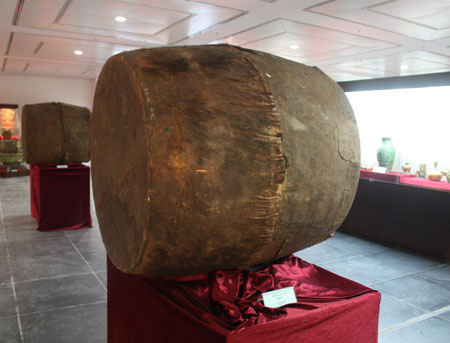
Dong Son bronze drum - a cultural symbol of Vietnamese people

A corner of Hanoi museum
Visiting Hanoi museum, tourists will have the opportunity to admire the antique things collected from around the country.
Let's up the third floor of the museum - the collection of space artifacts show artists' heart with their love for the capital- where displays documents and exhibits by organizations and individuals to donate, etc.
The fourth floor contains conference rooms, research rooms, offices and the library. With a lot of pottery such as bowls, vases ... or production tools, canoe found in Tien Giang and Ca Mau are on displayed on this floor.
Sunday, November 11, 2012
An original art of Vietnam
According to scholars specializing in portraying art, lacquer plays the first role in traditional materials in Vietnam's painting background. Opening to the world, Vietnam's lacquer paintings have got special attention because of its distinct nuance that strongly expresses national characters.
Yes, lacquer art has a centuries-old tradition in Vietnam, having first been introduced by the Chinese in the making of handicrafts and decorative items. In previous centuries, wooden statues in village's communal houses, temples, pagodas were red-lacquered and trimmed with gold. Altars, parallel sentences panels, and horizontal lacquered boards were handled by lacquering with sparkling colors.
Why was lacquer painting considered as an original art of Vietnam?
After the establishment of the Ecole des Beaux Arts de l’Indochine by the French in 1925, however, that anonymous craft performance became a new art form and was applied to paintings for the first time. At that time, the founders of the Ecole, Victor Tardieu and Joseph Inguimberty, recognized the beauty of the Vietnamese artistic traditions and wanted to help their students make the most of their heritage as well as teaching them Western painting. During the 20 years of its operation, the Ecole trained more than 100 Vietnamese artists who would become the pioneers of Vietnamese modern art, combining indigenous art forms with the art of Manet, Degas, Monet, Pissarro and Renoir. The 1930s was the time when lacquer paintings and other works of fine arts confronted a great renaissance. It confirmed that the ability to express ideas and feelings of lacquer paintings is unlimited.

Lacquer is a clear sap coming from of six species of trees growing in the North and the South Vietnam, both belonging to the familyAnacardiaceae. Lacquer - a harmless substance - is harvested in the same way as rubber by making an incision and letting the sap flow. Fresh lacquer is whitish and turns brown upon exposure to air. Black lacquer stems from a chemical reaction between lacquer and iron, then, it will be mixed with various natural or artificial dyes to produce the favorable colors. Surprisingly, several shades of red are extracted from a naturally occurring red mineral, cinnabar (mercuric sulfide). White is produced from eggshell. Eggs from ducks are used because they have a better structure than hens’ eggs. The eggshells are cleaned and sometimes even burned to obtain a brownish tinge.
Several other materials may be used to make lacquer paintings; the most common are gold leaf and silver leaf. Silver is used below the layers of colors to create an effect of immense luster. Gold leaf, on the other hand, is often applied as the final layer. An interesting use of gold leaf will make it appear as bright light flowing through the window. Besides, a range of other materials may also be used, such as shells, sand, epoxy and clay.
Applying colors and polishing
Painting with lacquer is a long and complex process requiring great skill and patience. It may take several months, depending on the specific technique of the artist and how many layers of lacquer are included. It involves the application of many layers of lacquer on a prepared wooden board, allowing each to dry in turn, and finally polishing the painting with pumice to reveal whatever colors the artist desires in different areas of the painting. Other materials used include eggshell to produce a white color, mother-of-pearl, gold and silver leaf. The final result is smooth and durable and will not crack due to fluctuations of temperature or humidity.
However, paintings after finishing need more time to be touched. It may be months, years, even plenty of years. The painters have to whet again and again their paintings to make them flat. Paints are drawn in many layers then can bring beautiful, occult and splendid colors. If you take notice, you can realize the capabilities and preeminence of different ones. Black lacquer is shiny, glossy and profoundly mysterious while cockroach-wing lacquer is lissome and limpid. Covering golden or silver color, the other colors can change to create derivative color bringing theatrical timbre. By coordinating ages of different-aged colors, color powders also become vaporous and radiant to finally make up sunk and floated parts of the paintings.

Many lacquer paintings and art objects of Vietnam have been brought overseas in mass. Painters, much or little, often draw lacquer paintings by sudden inspiration and following their flow of emotions. Vibration in their heart is reflected through the work without any rules or formulas. Because of those factors, the spirit in Vietnam's paintings turns to be profound.
There are some painters who have strong attachment with lacquer and have published resounding paintings such as Nguyen Sang with his work "Afternoon rest"; Tran Van Can with "Miss Thuy"; Phan Ke An with the painting "Missing one evening in North west"; To Ngoc Van and "Spending the night on roadside"; Mai Van Nam with "Going to Bac Ha market"; Nguyen Van Ty with "Thatched cottage and foot of jackfruit"; Tran Đinh Tho and "Bamboo"; and Nguyen Gia Tri with "Spring Garden", "Bailing water to prevent blood", and "The girl at hibiscus mutabilis flower".
In Vietnamese art treasure, besides lacquer paintings, there are many kinds of traditional paintings such as Dong Ho glazed paper paintings, oil-paintings, silk paintings.... Each type has its own special features that make Vietnamese people always feel proud when mentioning them with foreign friends from all over the world.
Stork island in Chi Lăng Nam
The stork island is located in Chi Lăng Nam commune, Thanh Miện district and stays about 25km far from Hải Dương city. Its pen name is An Dương by nature. It is called the stork village because the village has a small island located in the middle of broad lake with ten thousands of storks and herons residing and nesting. With an area of more than 3,000m2, the stork island is home to 15,000 storks and more than 5,000 herons of various kinds and such rare and precious birds as pelicans and teals residing together.
 |
| Photo: Đức Linh |
Located in the middle of vast lake, the stork island emerges as a pearl endowed by the nature for Chi Lăng Nam. The local residents still tell each other the legend for this land. It is said that at the beginning of the 15th century, deluges broke the large dyke along the Red River for three consecutive times. At the second breakage, an island emerged in the middle of the lake. Then, "birds perch good land", each herd of storks, herons and water birds come here from everywhere. With the time, storks and herons residing in the island are more and more crowded in the quantity and diversified in species.
From September to April every year, most storks can be seen with up to ten thousands of storks and thousands of herons perching in close proximity to one another on the bamboo tops and tree branches like flowers filled with white cotton from a remote view. They get together to nest, lay eggs and nurse their babies. The tourists are more excited to see young storks with immature legs on soft bamboo branches. When the sunset is let down, the storks return home. They fly into herds, each herd including 50 to 70 storks, even hundreds of storks creating true white curtains on the trees in the island. After flying for many times covering the whole lake space, they land safely on the green clump of trees in the middle of vast sea in the glow of sunset. It is followed by spans of the herons pending search for food at night. The tourists will witness an interesting "chorus" of families of storks and herons. The stork island is excited with sound like a natural chorus tearing a quite atmosphere of a Vietnamese village.
Tourists who come to the stork island in the season need only one day to visit the whole island. A small boat that is arranged so as not to disturb living environment of the storks will slowly take the tourists around the lake and see the life of storks. However, if the tourists expect to watch the live of storks more carefully, please stay overnight on the stork island. From 9.00 to 10.00, the storks come back most. The family reunion also starts from this time to the next morning. At that time, the tourists will have more time to study the life of storks on the island.
The harmonious intercalation between trees, birds and lake together with fresh, ventilated tropical weather as well as such historical and cultural monuments as temples, pagodas and traditional trade villages such as fish nursery, rice pancake, decorative plant, Chi Lăng Nam has full factors to become a typical ecological tourist area for the North Vietnam village. Hải Dương Tourism has made the tour on Chi LăngNam stork island a new tourist product of the province.
Thursday, November 8, 2012
Dak Nong's weather is cool year-round
The climate is relatively temperate regions, the annual temperature is 24 ° C, the hottest and coldest average difference of only 5 º C.
Dak Nong Province, Vietnam, is located in the southwest of Central region with the average height of 500m above sea level. Topographically, it is relatively flat, a immense plateau with pastures stretching to the east. Lower terrain to the west, and the south is the domain of many low-lying lakes.

Trinh Nu Waterfall
The climate is relatively temperate regions, with the annual temperature is 24°C, the hottest and coldest average difference of only 5ºC.
Dak Nong is suitable for visitors who love the majestic waterfall landscape, camp-fire night, the sound of gongs and the taste of the wine. Serepok River created many beautiful waterfalls, as benevolent as violent; Gia Long waterfall as a woman sleeping in wild and romantic and Dray Nur waterfall as a huge wall. Moreover, there are also many other majestic waterfalls, including Dieu Thanh waterfall, Ba Tang and Dray Sap waterfall known as Smoky waterfall.
Hon Mau island in Kien Giang
About 90km far from shore, Hòn Mấu is one of the twenty one small, beautiful and ideal islands in Nam Du archipelago (Kiên Hải district, Kiên Giang). Hòn Mấu is about 200ha wide with more than 120 households living nearby. Most of the island residents live on fishery and are very friendly and hospitable.
The nature has endowed Hòn Mấu with beautiful landscapes, 5 beaches on the island including 2 beaches Chướng and Nam with fine white sand that can be compared by any other places and three rocky beaches: Bắc, Đá Đen (Black Rock) and Đá Trắng (White Rock). Nambeach is the frontage of the island with almost smooth sea all the year round, thus the ships that come to do business stop here. This beach is also very clean.

The most interesting hobby is to wallow in cool water in Chướng beach. Such beach is like a huge water lake, surrounded by coconut rows and stretching sand banks, transparent turquoise water. Even you walk away for tens of meters, you will see the bottom. It is close to two rocky beaches with many beautiful rocks. Most of them are shiny black, so they are called Black Rocky Beach. Rocks in this beach are diversified in shapes and colors. When the sun darts its beams, rock under the sea is sparkling with many spectacular colors. Some rocks have quite strange patterns. Rock veins are tortuous in blue and red like marble veins. From Black Rocky Beach, you will reach WhiteRocky Beach after walking for around 15 minutes. The whole beach is filled only with white rocks. Rocks which are as small as fingers or as big as hands lie along the beach. This beach almost has no sand. Tourists coming to these rocky beaches wish to take some rocks as a gift of the sea.

According to Vietnam Institute of Geology and Minerals Research, Nam Du archipelago is structured by two formations. For rocky formation under fetsic volcanic system alone, it includes tufryolit and ryolit. At big cliffs, it is easy for tourists to image eruption of lava when forming these islands. Rocks are not slates with smooth surface but very rough and rapid like flowing lava of the volcano. Each rock fall bears its own feature to create strange-looking shapes, difficult but imposing positions in front of the sea.
Spending overnight in Hòn Mấu, tourists can feel the sea breath. After 11.00 pm, power generator stops working, the life on the island come back to the inherent deserted nature. Tourists have chance to sit next to the islanders by tea cups or sip rice alcohol with fish and snail caught from the sea while listening to sensational stories of Nam Du archipelago and Hòn Mấu.
Monday, November 5, 2012
Lam Kinh - A well-known historic relic
Lam Kinh is located in Xuan Lam Commune, Tho Xuan District, Thanh Hoa Province. It is 50km from Thanh Hoa City towards the Northwest. Here, tourists have a chance to visit a well-known historic relic related to the life and career of King Le Thai To, a famous king in Vietnamese history, and the uprising of the Lam Son troops in the 15th century.
After ten years of leading the Lam Son uprising to fight against the Northern invaders, Le Loi won and became a king in 1428 with the official name of Le Thai To. He set up the capital in Dong Kinh (Thang Long – present-day Hanoi). Simultaneously, he ordered an imperial city built in his birthplace and called it Lam Kinh or Tay Kinh.
According to historical documents and evidence found in the excavations in the area, the imperial city of Lam Kinh was built on a large-scale with the architectural style of “Noi cong, ngoai quoc” (the internal shape looks like the Chinese character “gong” and the external shape looks like the Chinese character “quo”). It includes magnificent buildings like a palace, a southern gate, an imperial temple and a dragon yard. The imperial city sits on Dau Mountain in the north and faces towards the Chu River in the south. In front of it is Chua Mountain, on the left is Phu Lam Forest and on the right is Huong Mountain.

After five centuries, most of the structures in Lam Kinh were ruined and now there remain only four imperial tombs of kings from the Le Dynasty and the tomb of Queen Ngo Thi Ngoc Giao, mother of King Le Thanh Tong. In 1962, Lam Kinh Historical Relic was recognized as a national historic relic by the State. In 1994, the Government approved a project to restore 50 of the structures, including the citadel, the Ngoc River, an ancient well, a triumphal arch, the southern gate, imperial temples, the palace and imperial tombs. With these valuable historical structures, the relic has become a famous tourist destination in Thanh Hoa Province.
To reach the central area of the royal citadel, visitors pass over a stone bridge crossing the Ngoc River. Walking for about 50m, tourists see a green plot of grass and an ancient well with clean and clear water. Next is the southern gate with a 300-year-old banyan tree covering up the roof of the gate and then a dragon yard. Passing the dragon yard, tourists come to the central palace where kings gave audience and discussed state affairs.

The central palace includes three large wood buildings which had great architectural value in the Le So Dynasty (1428-1527). Behind the central palace are nine imperial temples that were successfully restored.
From the central area of the royal citadel, on the roads paved with red bricks to forests tourists visit the tombs of kings in the Le Dynasty under green leaf canopies or climb up to the windy Dau Mountain and enjoy Tay Lake with its wild and poetic beauty.
From the central area of the royal citadel, on the roads paved with red bricks to forests tourists visit the tombs of kings in the Le Dynasty under green leaf canopies or climb up to the windy Dau Mountain and enjoy Tay Lake with its wild and poetic beauty.
Visiting the relics on August 22 of the lunar calendar, tourists not only enjoy a beautiful landscape and learn about the culture, architecture and history of this land but also participate in the Lam Kinh Festival with many traditional folk games. The festival is annually held on King Le Thai To’s death anniversary to commemorate his glorious achievements.
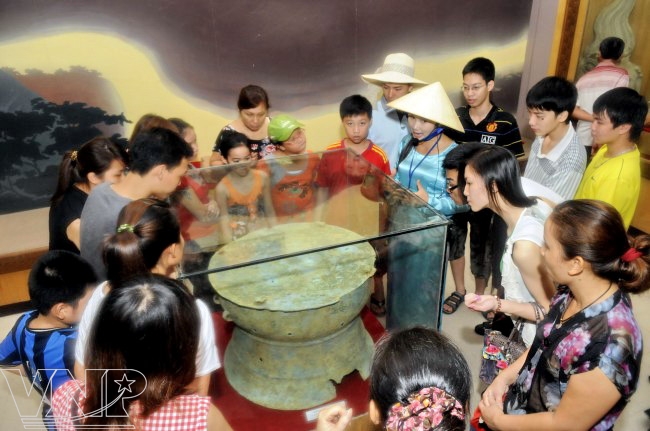
In the exhibition room at Lam Kinh Relic Site. Photo: Tran Thanh Giang
The best time for traveling to Nha Trang
The best time for traveling to Nha Trang would probably be March or April. The least windy months of the year are May, April and June. In general Nha Trang is not windy ennough to windsurf, with the exception of Doc Lep beach ( 35 km north of Nha Trang), which is usually reserved for experts.
 The weather in Nha Trang is warm and comfortable anytime during the year can be favorable for a trip to the tourism city. In summer often lasts from May with sunlight and hot weather, suitable for natural tourism such as ecotourism, ocean tourism or water sports; while the other months could be pleasing for tourists to visit cultural and historical places such as Ponagar Temple Tower, Vinpearl or The Nha Trang Aquarium.
The weather in Nha Trang is warm and comfortable anytime during the year can be favorable for a trip to the tourism city. In summer often lasts from May with sunlight and hot weather, suitable for natural tourism such as ecotourism, ocean tourism or water sports; while the other months could be pleasing for tourists to visit cultural and historical places such as Ponagar Temple Tower, Vinpearl or The Nha Trang Aquarium.
While most of the South of Vietnam is turned into water for half of a year by monsoon winds, Nha Trang experiences only four “wet months”, from September till mid-December, which are also a time to reconsider visiting Nha Trang. In the first eight months of the year, this coastal city enjoys a warm and beautiful weather and so any day between January and August is good time to start your holiday in Nha Trang.
Though long dry season gives beach lovers a big time budget to enjoy the sun-sea-sand in the area, tourists are advised to visit here before the late of June to avoid high humidity and tropical heat in two hottest months of the year (July and August).
The best time to visit Nha Trang would be from February till April, when temperature is kept around 26-27 degree Celsius, and precipitation stay at the lowest level of the year. Spring months are also the best time to dive here. Some coral-rich dive sites that diving enthusiasts should not miss out on are Small Hill, South Reef, and Moray Beach After, all around Mun Island.
If your trip is scheduled for July or August, remember to give Hòn Bà (30 km far from city center) the first position on your tourist attraction list. The mountain with cool climate all year round is absolutely a great place to hide from the summer heat.
Autumn travel in Nha Trang is not recommended. Though it is not cold, rainy, tropical storm and typhoon may annoy most of tourists. Visitors in Vietnam tourism planning to visit the area from September till December should keep your eyes on the local weather forecast.
Subscribe to:
Comments (Atom)







